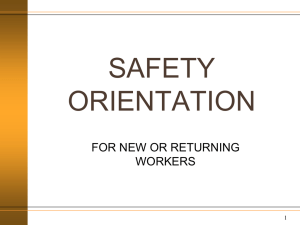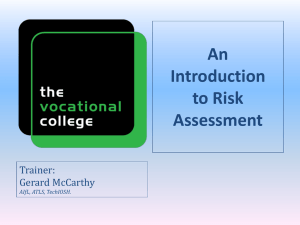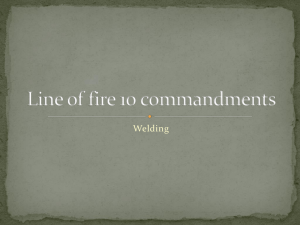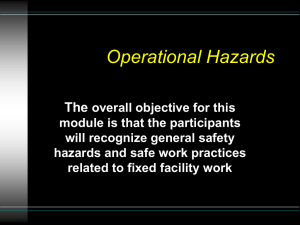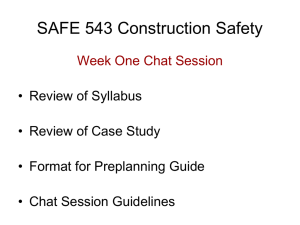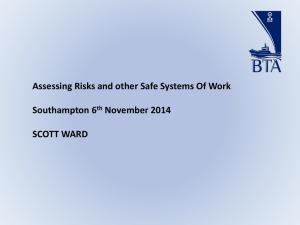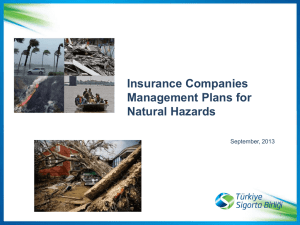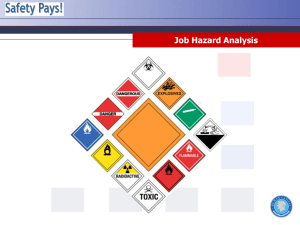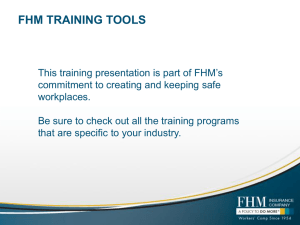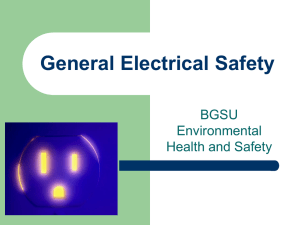Job Hazard Analysis
advertisement
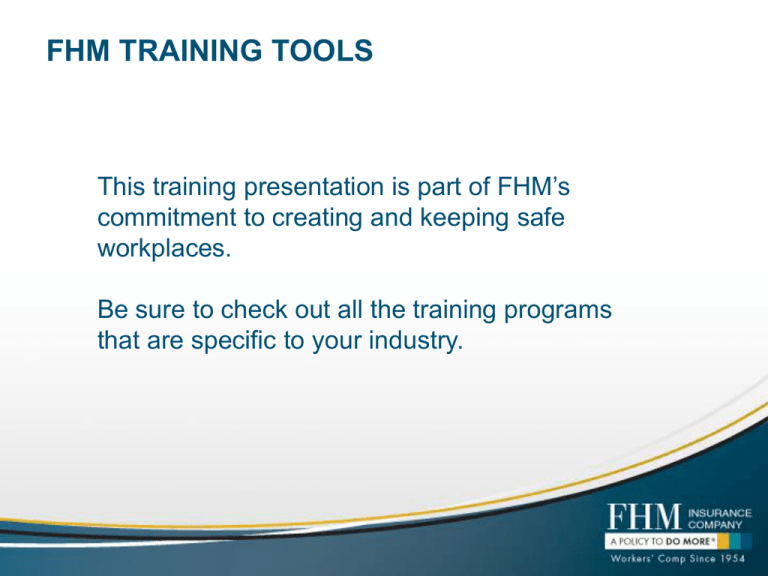
FHM TRAINING TOOLS This training presentation is part of FHM’s commitment to creating and keeping safe workplaces. Be sure to check out all the training programs that are specific to your industry. Job Hazard Analysis ►►► These materials have been developed based on applicable federal laws and regulations in place at the time the materials were created. The program is being provided for educational and informational purposes only and does not constitute and is not intended to provide OSHA compliance certification, regulatory compliance, a substitute for any "hands on“ training required by applicable laws and regulations, or other legal or professional advice or services. By accessing the materials, you assume all responsibility and risk arising from the use of the content contained therein. ©2010 Grainger Safety Services, Inc. Learning Objectives Objectives: ► Comprehensive list of hazards ► Apply the Job Hazard Analysis Tool to identify and control hazards Agenda Agenda: ► Common Workplace Hazards ► The Job Hazard Analysis Tool ►Section 1 Common Workplace Hazards Hazard Hazard: ► Often associated with a condition or activity that, if left uncontrolled, can result in an injury or illness ► Identifying hazards and eliminating or controlling them early will help prevent injuries and illnesses Common Hazards and Descriptions Toxic chemical: ► Chemical that exposes a person by absorption through the skin, inhalation, or through the bloodstream that causes illness, disease, or death Flammable chemical: ► Chemical that, when exposed to heat ignition source, results in combustion Corrosive chemical: ► Chemical that, when it comes into contact with skin, metal, or other materials, damages the materials Common Hazards and Descriptions Explosions caused by chemical reactions: ► Caused by the physical mixing of chemicals Explosions caused by over pressurization: ► Sudden and violent release of a large amount of energy due to a significant pressure difference Common Hazards and Descriptions Electrical: ► Contact with exposed conductors ► Overheating or arcing to the point of combustion ► Electrostatic discharge ► Loss of electrical power to critical equipment Common Hazards and Descriptions Ergonomic strains: ► Damage of tissue due to over exertion (strains and sprains) or repetitive motion Human error ergonomics: ► System designs, procedures, or equipment that is error-provocative Excavation hazards: ► Soil collapse in a trench or excavation as a result of improper or inadequate shoring Fall, slip, and trip hazards: ► Conditions that result in falls (impacts) from height or traditional walking surfaces Common Hazards and Descriptions Fire or high temperatures: ► Burns to the skin or damage to other organs Mechanical/Vibration hazards: ► Damage to nerve endings or material fatigue that results in a safety-critical failure Mechanical failures: ► Occur when devices exceed designed capacity or are inadequately maintained Mechanical hazards: ► Skin, muscle, or body part exposed to crushing, caught-between, cutting, tearing, shearing items or equipment Common Hazards and Descriptions Noise: ► Resulting in hearing damage or inability to communicate safety-critical information Ionizing radiation: ► Alpha, Beta, Gamma, neutral particles, and X-rays that cause tissue ionization of cellular components Non-ionizing radiation: ► Ultraviolet, visible light, infrared, and microwaves that cause injury to tissue by thermal or photochemical means Common Hazards and Descriptions Struck by hazards: ► Accelerated mass that strikes the body Struck against hazards: ► Coming into contact with a surface in which action was initiated by the person Temperature extremes: ► Heat stress, exhaustion, hypothermia Visibility hazards: ► Lack of lighting or obstructed vision that results in an error or other hazard Weather phenomena: ► Snow, rain, wind, or ice ►Section 2 The Job Hazard Analysis Tool Job Hazard Analysis Job Hazard Analysis: ► Focuses on the relationship between the worker, the task, the tools, and the environment ► A tool to help identify uncontrolled hazards and take steps to eliminate The Importance of Job Hazard Analysis Importance: ► Many workers are injured and killed at the workplace every day in the United States ► Preventing workplace injuries and illnesses involves looking at workplace operations, establishing proper job procedures, and ensuring that all employees are trained properly The Value of JHA Value: ► Supervisors can use the findings of a job hazard analysis to eliminate and prevent hazards ► A valuable tool for training new employees in the steps required to perform their jobs safely Selecting Jobs for Job Hazard Analysis Selection: ► Jobs with the highest injury or illness rates ► Jobs with the potential to cause severe or disabling injuries or illness, even if there is no history of previous accidents ► Jobs in which one simple human error could lead to a severe accident or injury ► Jobs that are new to your operation or have undergone changes in processes and procedures ► Jobs complex enough to require written instructions The Steps of JHA The steps: ► Involve employees ► Review accident history ► Conduct a preliminary job review ► List, rank, and set priorities for hazardous jobs ► Outline the steps or tasks Step One – Involve the Employees Step One: ► Unique understanding of the job, and this knowledge is invaluable for finding hazards ► Minimizes oversights ► Ensure a quality analysis ► Get workers to "buy in" to the solutions because they will share ownership in their safety and health program Step Two – Review the Accident History Step Two: ► Accidents and occupational illnesses that needed medical treatment ► Losses that required repair or replacement ► Near miss events in which an accident or loss did not occur, but could have ► These events are indicators that the existing hazard controls (if any) may not be adequate and deserve more scrutiny Conduct a Preliminary Job Review Step Three: ► Brainstorm ideas to eliminate or control those hazards ► If any hazards exist that pose an immediate danger to an employee's life or health, take immediate action to protect the worker ► Any problems that can be corrected easily should be corrected as soon as possible Step Four – List, Rank, and Set Priorities Step Four: ► List jobs with hazards that present unacceptable risks, based on those most likely to occur and with the most severe consequences ► These jobs should be your first priority for analysis Outline the Steps or Tasks Outline: ► Record enough information to describe each job action ► Avoid making the breakdown of steps too detailed ► Get input from other workers who have performed the same job ► Review the job steps with the employee to make sure you have not omitted something The JHA Form Form: ► Sequence of Basic Job Steps ► Potential Hazards ► Recommended Control Measures Sequence of Basic Job Steps Potential Hazards Recommended Control Measures An Example Task for JHA Development Example: ► What are the steps to accomplish this job, starting when the worker gets the initial work order from their lead worker? ► What are the hazards associated with each step? ► The control measures? The Four Steps of the JHA Form Sequence of Basic Job Steps ►Select ladder for task Potential Hazards ►Wrong type of ladder is selected Recommended Control Measures ►Training on ladder selection ►Poster with selection matrix ►Transport ladder to ►Lifting injury location ►Collision with other ►Require the use of lifting aids, two-person carry or spotter employees ►Facility ►Set-up ladder at task damage ►Unstable base location ►Ladder not functioning ►Training on proper ladder set-up Ladder inspection program properly ►Ascend ladder to perform task ►Fall from ladder during ascent ►Require 3 points of contact ►Basket/belt materials for tools and Reviewing the Job Hazard Analysis Review: ► Periodically reviewing your job hazard analysis ensures that it remains current and continues to help reduce workplace accidents and injuries ► It is possible that during the review you will identify hazards that were not identified in the initial analysis ► It is particularly important to review the job hazard analysis if an illness or injury occurs on a specific job ► Any time a job hazard analysis is revised, train all employees affected by the changes in the new job methods, procedures, or protective measures adopted Additional Information Additional information: ► Job Hazard Analysis. OSHA Publication 3071. 2002. ► Safety and Health Management System e-Tool: http://www.osha.gov/SLTC/etools /safetyhealth/mod4_tools_metho dologies.html

